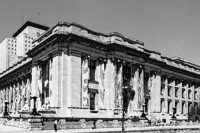From the open-air plaza on the 73rd floor of the Wilshire Grand Center in Los Angeles, the views extend to the southern California coast 50 miles out. With its distinctive rooftop spire making it the tallest building west of the Mississippi, the roof design is one of the most talked-about features of one of L.A.’s newest skyscrapers.
The project was granted an exemption from the city of Los Angeles code requiring buildings to have a rooftop helipad because of the addition of other fire safety features that would exceed the city’s fire code requirements, such as the reinforced concrete central core that contains a staircase solely for the use of firefighters in the event of an emergency.
In large-scale commercial building projects around the country, Xylem officials said its A-C Fire Pump brand aims to ensure the highest safety measures are in place for fire protection according to National Fire Protection Association (NFPA) 20 and local standards. Los Angeles and California building codes are among the most stringent in the country.
“One of the challenges was to design a system that met the city of L.A.’s requirement that total pressure shutoff can’t exceed 600 psi,” said Brian Buscher, global product manager for fire protection with Xylem AWS. “Our A-C Fire Pump distributor, Starfire Inc., worked closely with sprinkler contractor XL Fire Protection on the design.”
Brian Callahan, president of XL Fire Protection, accredited Certified Fire Protection Specialist (CFPS) by NFPA and level 4 certified NICET designer, sketched out a two-zone system that met the requirements for the high rise, worked within the space restraints of the fire pump room, and did not exceed maximum pressure requirements.
“One pump services the low zone, but the high-zone portion requires two pumps in series to create the 600 psi that was required. Once I knew the flow and pressure requirements, I was able to select the right combination of pumps to achieve that result,” said Starfire’s Paul Bennett.
A-C Fire Pump vertical turbine pumps and A-C Fire Pump 8200 Series horizontal split case pumps were selected for the job. Codes require an exact set of redundant fire pumps on each level, so that meant six fire pumps in total.
“By getting the number of pumps down to six, there was no need for an additional emergency generator, saving project cost,” Callahan said.
Once the design was conceived, the team had to be sure the system would work as planned.
“We had to do a lot of sizing and theoretical planning on what the pump curves would look like, especially in the high zone where the vertical turbines pump into the split case pumps and were approaching 600 psi,” Bennett said.
That also becomes more complicated because of NFPA 20 requirements for fire pump impellers, which state the pressure at shutoff cannot exceed 140% of the rated pressure at the rated flow and can’t be below 65% at 150% of the rated flow.
“One of the things we look at is not just the design point flow and head system needs, but also what the pressure is on the pump when it is at churn. We have to design the impeller to limit that pressure so that it is not overpressurizing the system components downstream of the pump,” Buscher said.
Even at shutoff, the static pressure in the turbine pumps was 77 psi, which required a pressure-reducing valve on the standpipe systems. “Controlling the pressure was our biggest challenge,” Callahan said.
The Wilshire Grand fire protection system design is also unique in the low-zone pump room, with the vertical turbines sitting atop a 120,000-gallon three-story water tank in the second of five basement levels — with space at a premium on the site, there was no room for it outside the building. Designers had to be sure this setup would meet the NFPA 20 requirement on how tanks are constructed and that the fire pump would be capable of providing demand for the whole building in an emergency.
The fire pump acceptance test was an essential step in obtaining the occupancy permit for the building. In testing the equipment, there was some fine-tuning in the time between turning on the pump and it feeding into the split case pump. By adjusting sequencing with the fire pump controller, the team was able to close the gap from 10 to 15 seconds at startup to just seven seconds. The system also met the challenge of the 600 psi requirement.
“In the end, everything worked as designed,” Callahan said. “It’s not just putting in products; everything had to perform properly as a system and meet code.”


